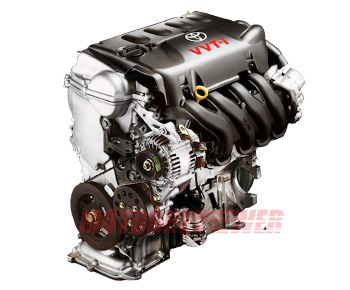Toyota 1NZ-FE/FXE 1.5L Engine Specs, Problems & Reliability

The Toyota NZ family is a series of small-displacement gasoline engines that were first introduced in 1997. The 1NZ-FE is a 1.5-liter four-cylinder gasoline engine, a conventional Otto cycle version of the 1NZ-FXE used in the XW10 Prius. This small 1.5L engine was used in a big variety of cars - Toyota Yaris/Echo, Toyota Auris, Toyota Probox, Scion xB, and other compact sedans, hatchbacks produced by Toyota and primarily sold in Japan and Asian countries. The NZ family also has a smaller version - 1.3-liter 2NZ-FE.
The 1NZ-FE has an aluminum alloy "open deck" cylinder block with thin-walled, spiny type cast-iron liners. The distance between the bores is 8 mm. The engine block design features an offset crankshaft by 12 mm towards the intake side relative to the cylinder bore centerline. The forged steel crankshaft had four balance weights, five journals, and an integrated crankshaft position sensor. The 1NZ engine is equipped with forged steel connecting rods and light-weight aluminum alloy pistons with semi-floating type piston pins, low-tension rings, and a friction-reducing polymer coating (LFA - Low Friction Resin with Alumina).
The cylinder head is made of aluminum alloy and has four valves per cylinder. Each cylinder has two intake and two exhaust valves. The intake valve diameter is 30.5 mm and the exhaust - 25.5 mm. The valve stem diameter for both valve types is 5.0 mm. The engine has double overhead camshafts (DOHC) which driven by a roller timing chain (8.0 mm pitch, single-row). The intake is equipped with the VVT-i system (variable valve timing). The valvetrain has shimless, solid valve lifters/tappets (the valve clearance adjustment is required by replacing a set of tappets). The 1NZ has a traditional multipoint, sequential fuel injection. It uses injectors with multi-hole nozzles (12 holes) and operates with the fuel pressure about 325 kPa. To reduce the weight and heating of the intake air, the intake manifold is made of plastic. Until 2005, there war a mechanical throttle body, and then, since the beginning of 2005, the engine was equipped with a fully electronically controlled throttle valve (Toyota's ETCS). The engine has distributorless Direct Ignition System (Toyota's DIS) which comes with an individual ignition coil for each cylinder and spark plugs with iridium center electrode.
In 2003, the 1NZ-FE engine was revised. The cylinder head received hydraulic lash adjusters and roller rockers for the valve mechanism. The angle between intake and exhaust valves was reduced from 33 to 21 degrees. The upgraded engine got new pistons, new exhaust manifold, a new modified-construction three-way catalytic converter plus the second additional converter, EGR system, and iridium spark plugs with a long threaded portion.
The 1NZ-FXE Engine (1.5 EFI HYB)
The 1NZ-FXE is a version for Toyota's hybrid vehicles - Toyota Prius (XW10, XW20), Toyota Prius c, Yaris Hybrid, and etc. The 1NZ-FXE engine uses Atkinson Cycle, rather than a conventional Otto cycle. This is achieved by keeping the intake valves open during the initial stage of the compression stroke allowing a reverse flow of intake air into the intake manifold. That means the reduction in cylinder charge and reduced torque and power output, but efficiency is increased. The compression ratio is very high for gasoline engine - 13.0:1. This engine variant has an aluminum intake manifold fitted with a linkless-type throttle body - Toyota's ETCS-i. The ETCS-i also controls the IAC (Idle Air Control) system and cruise control. The ignition system is Toyota's Electronic Spark Advance (ESA).
In 2012, the manufacturer made some changes in the design of this engine, special for the upcoming Prius c, European Yaris Hybrid, and Prius Aqua for Japan market. An improved version features a higher 13.4:1 compression ratio, water-cooled exhaust gas recirculation (EGR), a low-friction cam chain, cold intake, and belt-less operation of the water pump and air conditioning compressor. The stainless steel exhaust manifold has an integrated catalytic converter and forms a one-piece exhaust system.
Engine Specs
Siam Toyota Manufacturing in Chonburi, Thailand
Indus Motor Company in Karachi, Pakistan
13.0:1 - 1997-2011 1NZ-FXE;
13.4:1 - 2012+ 1NZ-FXE
74-76 (55-57 kW)/4,800-5,000 - 1NZ-FXE
82-85 lb-ft (111-115 Nm)/3,600-4,400 - 1NZ-FXE
The 1NZ-FE/FXE Engine Problems and Reliability
Toyota's 1.5L 1NZ engine is a typical modern engine. There are practically no problems with 1NZ-FE/FXE engines on mileages up to 100,000 miles. But after that line, be prepared for high oil consumption, which usually increases during long rides with high rpm. Increased oil consumption primarily happens due to stuck piston rings or bad valve seals. At about the same mileage, the timing chain is stretched out and begins to rattle, as well as the VVT actuator starts producing some noise after cold starts.
Different oil leaks and oil sweating are common for the 1NZ engine. The weak spot is a rear crankshaft oil seal, and leakages from under the chain cover or chain tensioner are not rare. In the early 2000s, vehicles with 1NZ engines took part in recall campaign due to risk of signal missing from the crankshaft position sensor caused by oil leakage and its penetration inside the sensor connector.
The next common problem is unstable idle or, sometimes, unusually low idle rpm. At the same time, sometimes it supplements by loss of power at middle rpm range. Most often, a simple throttle cleaning helps. But sometimes the issue is in ISCV, MAF-sensor, and PCV valve.
